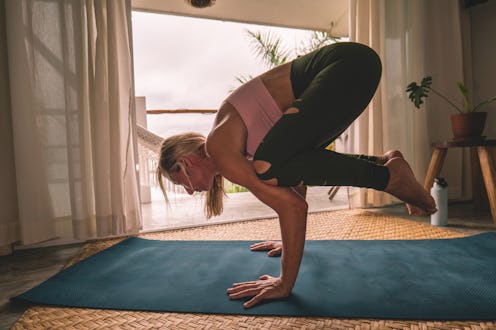Fitness
The Secret To Mastering Crow Pose In Yoga
Test your balancing skills.

Crow pose is one of those challenging yoga moves that look really cool once you master them. See also: Dua Lipa doing the move in her Vogue “73 Questions” video — in jeans and heels, no less. It’s a yoga pose that tests your balance and physical strength, but also your ability to focus as you maneuver your entire body weight onto the backs of your arms. While it looks like a totally advanced posture, learning how to do crow pose is more achievable than you might think.
Also called kakasana, crow pose is an arm balancing move where you rest your knees on your elbows while remaining steady on your hands, says Laurie Alfano, a yoga instructor and founder of Noga Movement. It’s a pose you can aim to do as a personal challenge, as well as one that works wonders as part of a regular practice.
For starters, crow pose is incredibly strengthening. “The pose requires a significant amount of upper body strength, particularly in the wrists, arms, and shoulders,” Alfano tells Bustle, so practicing it on the regular will help strengthen those areas. It also requires you to engage your entire core to stay steady as you balance, which effectively boosts your core stability.
As it goes with any balancing pose, trying the crow is a fun way to build on your confidence, too. “Attempting an arm balance like crow can be challenging, and successfully holding the pose can give you a sense of accomplishment,” Alfano says. On top of that, since it requires so much focus, learning how to do crow pose can help improve your ability to concentrate. Read on for an expert guide to nailing the yoga posture.
How To Do Crow Pose
Here, Alfano breaks down how to do a crow pose using good form.
- Start in a squatting position with your feet hip-width apart.
- Open your knees slightly wider than your hips.
- Place your hands shoulder-width apart on the mat in front of you with fingers spread wide.
- Bring your gaze forward.
- Engage your core by drawing your navel towards your spine.
- Begin to shift your weight forward.
- Bring your knees up towards your triceps, placing them on the backs of your upper arms.
- Keep your elbows close to your body and your wrists directly under your shoulders.
- Slowly begin to lift your hips.
- Support your weight on your hands and knees.
- Keep your gaze forward and your core engaged.
- Press through the balls of your feet to lift your toes off the mat.
- Hold the pose for a few breaths.
- Release by bringing your knees back down to the mat and returning to a squatting position.
How To Ease Into Crow Pose
If you’re not quite ready for the full pose, you can start by raising just one foot — or even just your big toe — off the ground, says Mimi Ghandour, a yoga instructor and founder of Mimi Yoga. Then try the next foot. “Eventually, go for it and lift both,” she tells Bustle.
You can also incorporate yoga blocks to give you a bit more height. “Place your feet on the block and place your hands on the floor in a squatting position,” Ghandour says. “Lean forward and begin raising one foot off the ground at a time.” If you’re worried about tipping forward onto your face, she recommends putting a pillow or blanket in front of you for added security.
The wall is your friend, too. “If you're having trouble balancing, place your hands close to a wall and use it for support,” Alfano says. “Modifying the pose can help you to build the strength and flexibility needed to progress towards the full pose in a safe and sustainable way.”
It’s also a good idea to practice other balancing poses like dolphin, side plank, and even regular plank on your journey to crow. “It's important to remember that every body is different, so it may take time and patience to build the strength and flexibility necessary to do the full pose,” Alfano adds.
With time, you can take the crow to the next level. “Once you’re able to hold crow consistently, you can amplify it by taking it to a one-legged crow, or even transition from crow pose to a headstand,” Ghandour says. “You can also learn to jump back into chaturanga from crow, where you shoot your legs back and land in a low plank.” Advanced yogi goals.
Common Crow Pose Mistakes To Avoid
When doing crow pose, it’ll be tempting to look down between your hands, Ghandour says, but it’s important to maintain a steady forward gaze. This will help you balance and ensure that you’re holding the pose correctly. You’ll also want to keep your arms in tight instead of out to the sides. “Your elbows should be facing straight back,” she says. From there, keep your core engaged and your back rounded, and you’ll be well on your way to mastering the crow.
Sources:
Laurie Alfano, yoga instructor founder of Noga Movement
Mimi Ghandour, yoga instructor, founder of Mimi Yoga
This article was originally published on